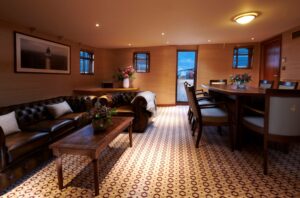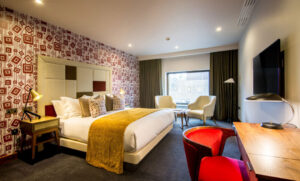Introduction:
In the fast-paced landscape of commercial spaces, selecting the right furniture is not just about visual appeal; it’s a strategic decision that can significantly impact the overall efficiency and ambiance of a workplace. This article delves deeply into the critical importance of contract quality furniture, going beyond mere aesthetics to explore its role in durability, functionality, compliance, and the lasting impact on both employees and clients.
Defining Contract Quality Furniture
Understanding the nuances of contract quality furniture is foundational to appreciating its role in commercial spaces. We’ll delve into the specifications and standards that differentiate furniture suitable for commercial use, emphasizing not only the visual aspects but also the necessity for durability, functionality, and compliance with safety regulations.
Commercial Furniture Standards and Certifications: Explore industry standards and certifications that define contract quality furniture. This section provides a detailed breakdown of certifications such as ANSI/BIFMA for office furniture and other relevant quality benchmarks.
Materials and Construction: Delve into the materials commonly used in contract quality furniture, such as robust metals, high-quality woods, and durable fabrics. Discuss how specific construction methods contribute to the longevity and reliability of these pieces.
Durability and Longevity
One of the defining features of contract-quality furniture is its ability to withstand the demands of daily use in a commercial setting. In this section, we’ll explore in-depth the various factors that contribute to the durability and longevity of contract-grade furnishings.
Impact on Total Cost of Ownership: Discuss the concept of total cost of ownership in the context of furniture. Analyze how the initial investment in contract quality furniture, though potentially higher, is often offset by its extended lifespan and reduced maintenance costs.
Resistance to Wear and Tear: Explore how contract furniture is designed to resist the wear and tear associated with heavy use. This includes considerations such as scratch resistance, stain resistance, and the ability to maintain structural integrity over time.
Environmental Factors: Discuss how contract quality furniture considers environmental factors, such as temperature and humidity fluctuations, which are common in commercial spaces. Highlight how this resilience contributes to the furniture’s overall durability.
Functionality for Productivity
The functionality of office furniture directly correlates with the productivity and well-being of employees. In this section, we’ll explore the ergonomic features of contract quality furniture and how they contribute to a more efficient and enjoyable work environment.
Ergonomics and Employee Comfort: Delve into the ergonomic design principles that guide the creation of contract quality furniture. Discuss how features like adjustable chairs, sit-stand desks, and proper lighting contribute to employee comfort and well-being.
Health Benefits: Explore the health benefits associated with ergonomic furniture, such as improved posture, reduced risk of musculoskeletal disorders, and increased overall job satisfaction. Reference relevant studies and statistics to underscore the importance of investing in employee well-being.
Productivity Impact: Discuss the direct correlation between comfortable, well-designed workspaces and increased productivity. Cite examples of companies that have seen measurable improvements in employee performance after implementing contract quality furniture.
Compliance and Safety
Ensuring the safety and well-being of occupants is a paramount concern in commercial spaces. In this section, we’ll delve into the importance of compliance with industry standards and safety regulations, and how contract quality furniture plays a crucial role in meeting these requirements.
Adherence to Industry Standards: Provide an in-depth overview of the specific industry standards that govern different types of commercial furniture. Discuss how adherence to these standards ensures that furniture meets minimum safety and quality requirements.
Fire Safety: Explore the significance of fire safety standards in commercial furniture. Discuss flame retardant materials, certification requirements, and the role of contract quality furniture in creating a safer work environment.
Occupational Health and Safety: Highlight the importance of creating a workspace that minimizes the risk of workplace injuries. Discuss how features like ergonomic design, proper spacing, and adherence to safety standards contribute to occupational health and safety.
Aesthetic Appeal and Brand Image
While functionality and safety are paramount, the visual appeal of a workspace should not be overlooked. In this section, we’ll explore how contract quality furniture contributes to the aesthetic appeal of a commercial space and its impact on brand image.
Professionalism and Cohesiveness: Discuss how well-designed and coordinated furniture creates a professional and cohesive visual identity for a business. Explore the psychological impact of a visually appealing workspace on both employees and clients.
Customization Options: Highlight the customization options available with contract furniture. Discuss how businesses can tailor their furniture choices to align with branding elements, color schemes, and overall design aesthetics.
Client and Visitor Perception: Explore how the visual appeal of a workspace influences the perception of clients and visitors. Discuss case studies or examples of businesses that have successfully used contract quality furniture to enhance their brand image.
Versatility and Adaptability
Commercial spaces are dynamic environments that often undergo changes in layout and functionality. In this section, we’ll explore how contract quality furniture excels in versatility and adaptability, allowing businesses to respond to evolving needs.
Modular Furniture Solutions: Discuss the prevalence of modular and customizable contract furniture options. Explore how businesses can easily reconfigure their layout to accommodate growth, changes in team structure, or evolving work processes.
Future-Proofing Investments: Highlight the concept of future-proofing through furniture choices. Discuss how investing in contract quality furniture ensures that businesses can adapt to changes without the need for a complete overhaul of their furniture systems.
Sustainability Considerations: Explore how sustainability is integrated into the design of contract furniture. Discuss eco-friendly materials, manufacturing processes, and the overall environmental impact of choosing adaptable, long-lasting furniture.
Conclusion:
In conclusion, the decision to invest in contract furniture for commercial spaces goes far beyond a superficial consideration of aesthetics. It is a strategic investment in the efficiency, safety, and overall success of a business. By prioritizing durability, functionality, compliance, and aesthetic appeal, businesses can create workspaces that not only impress clients but also foster employee well-being and productivity. In an era where the physical environment plays a crucial role in the success of a business, the careful selection of contract quality furniture emerges as a cornerstone for creating workspaces that seamlessly blend efficiency with elegance.
Discovering the Essence of British Elegance: Hotel Bedroom Furniture in UK
Visit Us on LinkedIn




